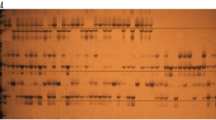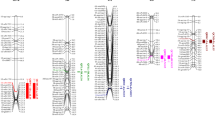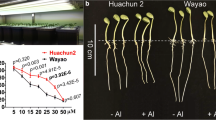Abstract
Aluminum toxicity is one of the major constraints for plant development in acid soils, limiting food production in many countries. Cultivars genetically adapted to acid soils may offer an environmental compatible solution, providing a sustainable agriculture system. The aim of this work was to identify genomic regions associated with Al tolerance in maize, and to quantify the genetic effects on the phenotypic variation. A population of 168F3:4 families derived from a cross between two contrasting maize inbred lines for Al tolerance was evaluated using the NSRL and RSRL parameters in nutrient solution containing toxic level of aluminum. Variance analyses indicated that the NSRL was the most reliable phenotypicindex to measure Al tolerance in the population, being used for further QTL mapping analysis. RFLP and SSR markers were selected for bulked segregant analysis, and additional SSR markers, flanking the polymorphisms of interest, were chosen in order to saturate the putative target regions. Seven linkage groups were constructed using 17 RFLP and 34 SSR markers. Five QTLs were mapped on chromosomes 2, 6 and 8, explaining 60% of the phenotypic variation. QTL4 and marker umc043 were located on chromosomes 8and 5, close to genes encoding for enzymes involved in the organic acids synthesis pathways, a widely proposed mechanism for Al tolerance in plants. QTL2 was mapped in the same region as Alm2,also associated with Al tolerance in maize. In addition, dominant and additive effects were important in the control of this trait in maize.
Similar content being viewed by others
References
Aranza, F., Y. Tadmor, B.P. Klein, T.R. Rocheford & J.A. Juvik, 1996. Quantitative trait loci influencing chemical and sensory characteristics of eating quality in sweet corn. Genome 39: 40-50.
Austin, D.F. & M. Lee, 1998. Detection of quantitative trait loci for grain yield and yield components in maize across generations in stress and nonstress environment. Crop Sci 38: 1296-1308.
Basten, C., B.S. Weir & Z.B. Zeng, 1998. QTL Cartographer: a reference manual and tutorial for QTL mapping. North Carolina State University, Raleigh, N.C., pp. 132.
Brondani, C. & E. Paiva, 1996. RFLP analysis of aluminum tolerance in chromosome 2 in maize. Pesq Agropec Bras 8: 575-579.
Burr, B., F. Burr, K.H. Thompson, M.C. Albertsen & C.W. Stuber, 1988. Gene mapping with recombinant inbreds in maize. Genetics 118: 519-526.
Cançado, G.M.A., L.L., Loguercio, P.R., Martins, S.N., Parentoni, M.A., Lopes, E. Paiva & A. Borém, 1999. Hematoxylin staining as a phenotypic index for aluminum tolerance selection in tropical maize. Theor Appl Genet 99: 747-754.
Cruz, C.D., 1997. Programa GENES: aplicativo computacional em genética, estatística. Editora UFV, Viçosa, Brazil.
Doerge, R.W. & G.A. Churchill, 1996. Permutation test for multiple loci affecting a quantitative character. Genetics 142: 285-294.
Fuente, J.M., V. Ramírez-Rodriguez, J.L. Cabrera-Ponce & L. Herrera-Estrella, 1997. Aluminum tolerance in transgenic plants by alteration of citrate synthesis. Science 276: 1566-1568.
Galvão, J.D. & J.C. Silva, 1978. Herança da tolerância ao alumínio na variedade de milho Piranão. Rev Ceres 137: 71-78.
Goodman, M.M., C.W. Stuber, K. Newton & H.H. Weissinger, 1980. Linkage relationships of 19 enzyme loci in maize. Genetics 96: 697-710.
Jansen, R.C. & P. Stam, 1994. High resolution of quantitative traits into multiple loci via interval mapping. Genetics 136: 1447-1455.
Kochian, L.V., 1995. Cellular mechanisms of aluminum toxicity and resistance in plants. Ann Rev Plant Physiol Plant Mol Biol 46: 237-260.
Kosambi, D.D., 1944. The estimation of map distances from recombination values. Ann Eugenet 12: 172-175.
Lima, M., P.R. Furlani & J.B. Miranda Filho, 1992. Divergent selection for aluminum tolerance in a maize (Zea mays L.) population. Maydica 37: 123-132.
Lima, M., J.B. Miranda Filho & P.R. Furlani, 1995. Diallel cross among inbred lines of maize differing in aluminum tolerance. Brazil J Genet 4: 579-584.
Lopes, M.A., R. Magnavaca, A.F.C. Bahia Filho & E.E.G. Gama, 1987. Avaliação de populações de milho e seus cruzamentos para a tolerância à toxidez do Al em solução nutritiva. Pesq Agrop Bras 22: 257-263.
Lübberstedt, T., A.E. Melchinger, S. Fahr, D. Klein, A. Dally & P. Westhoff, 1998. QTL mapping in testcrosses of flint lines of maize: III Comparison across populations for forage traits. Crop Sci 38: 1278-1289.
Ma, J.F, P.R. Ryan & E. Delhaize, 2001. Aluminium tolerance in plants and complexing role of organic acids. Trends Plant Sci 6: 273-278.
Magnacava, R., C.O. Gardner & R.B. Clark, 1987. Evaluation of inbred maize lines for aluminum in nutrient solution. In: H.W. Gabelman & B.C. Loughman (Eds.), Genetics Aspects of Plant Mineral Nutrition, pp. 255-265. Martinus Nijhoff Publishers, Dordrecht.
Martins, P.R., S.N. Parentoni, M.A. Lopes & E. Paiva, 1999. Efficiency of root length phenotypic index in the evaluation of individual maize plants for aluminum tolerance. Pesq Agropec Bras 34: 1897-1904.
Mather, K. & J.L. Jinks, 1971. Biometrical Genetics. Cornell University Press, Ithaca.
Michelmore, R.W., I. Paran & R.V. Kesseli, 1991. Identification of markers linked to disease-resistance genes by bulked segregant analysis: a rapid method to detect markers in specific genomic regions by using segregating populations. Proc Natl Acad Sci USA 88: 9828-9832.
Olmos, J.I.L. & M.N. Camargo, 1976. Ocorrência de Al tóxico nos solos do Brasil, sua caracterização e distribuição. Ciência e Cultura 28: 171-180.
Pandey, S. & C.O. Gardner, 1992. Recurrent selection for population, variety, and hybrid improvement in tropical maize. Adv Agron 48: 1-87.
Parentoni, S.N., V.M.C. Alves, S.K. Milach, G.M. Almeida & A.F.C. Bahia Filho, 2001. Melhoramento para a tolerância ao alumínio como fator de adaptação a solos ácidos. In: L.L. Nass, A.C.C. Valois, I.S. Melo & M.C. Valadares-Ingli (Eds.), Recursos Genéticos e Melhoramento-Plantas, pp. 783-854. Fundação MT, Rondonópolis.
Pellet, D.M., D.L. Grunes & L.V. Kochian, 1995. Organic acid exudation as an aluminum-tolerance mechanism in maize (Zea mays L.). Planta 196: 788-795.
Penner, G.A., J. Chong, M. Levesque-Lemay, S.J. Molnar & G. Fedak, 1993. Identification of a RAPD marker linked to the oat stem rust gene Pg3. Theor Appl Genet 85: 702-705.
Prioli, A.J., 1987. Análise genética da tolerância à toxidez do alumínio em milho (Zea mays L. ). Campinas: Unicamp, 182 p. Ph.D. Thesis.
Ragot, M. & D.G. Hoisington, 1993. Molecular markers for plant breeding: comparisons of RFLP and RAPD genotyping costs. Theor Appl Genet 86: 975-984.
Reiter, R.S., J.G.K. Williams, K.A. Feldmann, J.A. Rafalsky, S.V. Tingey & P.A. Scolnik, 1992. Global and local genome mapping in Arabidopsis thaliana by using recombinant inbred lines and random amplified polymorphic DNAs. Proc Natl Acad Sci USA 89: 1477-1481.
Rhue, R.D., C.O. Grogan, E.W. Stockmeyer & H.L. Everett, 1978. Genetic control of aluminum tolerance in corn. Crop Sci 18: 1063-1067.
Saghai-Maroof, M.A., K.A. Soliman, R.A. Jorgensen & R.W. Allard, 1984. Ribosomal DNA spacer length polymorphism in barley: Mendelian inheritance, chromosomal location and population dynamics. Proc Natl Acad Sci USA 81: 8014-8018.
Sari-Gorla, M., P. Krajewski, G. Binelli, C. Frova, G. Taramino & M. Villa, 1997. Genetic dissection of herbicide tolerance in maize by molecular markers. Mol Breed 3: 481-493.
Sawasaki, E. & P.R. Furlani, 1987. Genética da tolerância ao alumínio em milho cateto. Bragantia 46: 269-278.
Schön, C.C., M. Lee, A.E. Melchinger, W.D. Guthrie & W.L. Woodman, 1993. Mapping and characterization of quantitative trait loci affecting resistance against-second generation European corn borer in maize with the aid of RFLPs. Heredity 70: 646-659.
Scott, A.J. & M.A. Knott, 1974. Cluster analysis method for grouping means in the analysis of variance. Biometrics 30: 507-512.
Senior, M.L., E.C.L. Chin, M. Lee, J.S.C. Smith & C.W. Stuber, 1996. Simple sequence repeat developed from maize sequences found in the Genbank Database: map construction. Crop Sci 36: 1676-1683.
Sibov, S.T., M. Gaspar, M.J. Silva, L.M.M. Ottoboni, P. Arruda & A.P. Souza, 1999. Two genes control aluminum tolerance in maize: genetic and molecular mapping analyses. Genome 42: 1-8.
Stuber, C.W., M.D. Edwards & J.F. Wendell, 1987. Molecular marker-facilitated investigations quantitative trait loci in maize: II Factors influencing yield and its component traits. Crop Sci 27: 639-648.
Stuber, C.W., S.E. Lincoln, D.W. Wolff, T. Hellentjaris & E.S. Lander, 1992. Identification of genetic factors contributing to heterosis in a hybrid from two elite maize inbred lines using molecular markers. Genetics 132: 823-839.
Torres, G.A., S.N. Parentoni, M.A. Lopes & E. Paiva, 1997. A search for RFLP markers to identify genes for aluminum tolerance in maize. Brazil J Genet 3: 459-465.
Tuberosa, R., M.C. Sanguineti, P. Landi, S. Salvi, E. Casarini & S. Conti, 1998. RFLP mapping of quantitative trait loci controlling abscisic acid concentration in leaves of drought-stressed maize (Zea mays L.). Theor Appl Genet 97: 744-755.
Veldboom, L.R. & M. Lee, 1996. Genetic mapping of quantitative trait loci in maize in stress and nonstress environments: I grain yield and yield components. Crop Sci 36: 1310-1319.
Vencovsky, R., 1987. Herança quantitativa. In: E. Paterinani & G.P. Viegas (Eds.), Melhoramento e Produção de Milho, pp. 135-2142. Fundação Cargill, Campinas.
Wang, G.L. & A.H. Paterson, 1994. Assessment of DNA pooling strategies for mapping QTLs. Theor Appl Genet 88: 355-361.
Zeng, Z.B., 1994. Precision mapping of quantitative trait loci. Genetics 136: 1457-1468.
Author information
Authors and Affiliations
Rights and permissions
About this article
Cite this article
Ninamango-Cárdenas, F.E., Teixeira Guimarães, C., Martins, P.R. et al. Mapping QTLs for aluminum tolerance in maize. Euphytica 130, 223–232 (2003). https://doi.org/10.1023/A:1022867416513
Issue Date:
DOI: https://doi.org/10.1023/A:1022867416513




